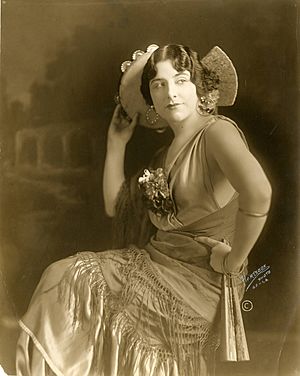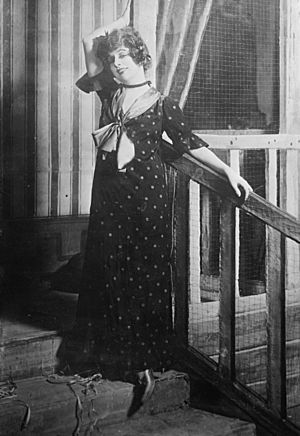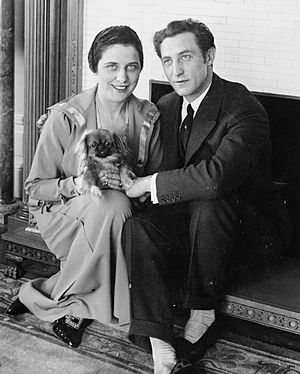Geraldine Farrar facts for kids
Quick facts for kids
Geraldine Farrar
|
|
|---|---|
 |
|
| Born |
Alice Geraldine Farrar
February 28, 1882 Melrose, Massachusetts, U.S.
|
| Died | March 11, 1967 (aged 85) Ridgefield, Connecticut, U.S.
|
| Occupation | Opera singer, actress |
| Years active | 1901–1922 |
| Spouse(s) |
Lou Tellegen
(m. 1916; div. 1923) |
Alice Geraldine Farrar (born February 28, 1882 – died March 11, 1967) was a famous American opera singer. She was known for her beautiful voice and great acting skills. Geraldine could sing both lyric soprano and dramatic opera parts. She was very popular, especially among young women, who were sometimes called "Gerry-flappers."
Contents
Biography of a Star
Geraldine Farrar was born in Melrose, Massachusetts. Her father, Sid Farrar, was a baseball player. Geraldine started studying music in Boston when she was only five years old. By the time she was 14, she was already giving concerts!
She later studied singing with famous teachers in New York City, Paris, and Berlin. In 1901, Geraldine made her first big appearance at the Berlin State Opera. She sang the role of Marguerite in the opera Faust. She stayed with the company for three years, learning even more from the famous German singer Lilli Lehmann.
Geraldine also sang in other popular operas like Mignon, Manon, and Roméo et Juliette.
Singing at the Metropolitan Opera
After singing for three years at the Opéra de Monte-Carlo, Geraldine Farrar came back to the United States. She made her debut at the New York Metropolitan Opera on November 26, 1906. She sang in Roméo et Juliette.
In 1907, she performed in the first Met show of Giacomo Puccini's Madama Butterfly. Geraldine was a main singer at the Metropolitan Opera until she retired in 1922. She performed 29 different roles in 672 shows! She was incredibly popular, especially with young female opera fans in New York.
Geraldine also created new roles in operas. She was the first to sing the main parts in Pietro Mascagni's Amica (1905) and Puccini's Suor Angelica (1918). A fun fact is that for her role as the Goosegirl in Königskinder (1910), Geraldine actually trained her own flock of geese! After one show, she even came out for a bow with a live goose under her arm.

From Opera to Films and Radio
Geraldine Farrar made many recordings for the Victor Talking Machine Company. She also became a movie star! Between opera seasons, she acted in silent films. From 1915 to 1920, she starred in more than a dozen movies.
One of her most famous film roles was in Cecil B. DeMille's 1915 movie Carmen, based on the opera. People loved her performance. The San Francisco Call & Post newspaper said her Carmen movie was a huge success. Another important role was Joan of Arc in the 1917 film Joan the Woman.
In June 1931, Geraldine Farrar made her first radio broadcast. She sang over the National Broadcasting Company's nationwide "Red" network.
In 1960, Geraldine Farrar received two stars on the Hollywood Walk of Fame. These stars honor her work in music and film.
Later Life and Legacy
Geraldine Farrar married actor Lou Tellegen on February 8, 1916. Their marriage ended in divorce in 1923.
She retired from opera in 1922 when she was 40 years old. Her last performance was in the opera Zazà. Geraldine had worked very hard, performing many times each season. For example, she sang as Madama Butterfly 95 times and as Carmen 58 times during her 16 seasons at the Met.
After retiring from opera, Geraldine continued to perform in concerts. She also kept making recordings. For a short time in 1934–35, she was a commentator for the Metropolitan Opera radio broadcasts. In 1938, she wrote her autobiography, Such Sweet Compulsion.
Geraldine Farrar passed away in Ridgefield, Connecticut in 1967 at the age of 85. She was buried in Kensico Cemetery in Valhalla, New York. She did not have any children.
Filmography
| Year | Title | Role | Notes |
|---|---|---|---|
| 1915 | Carmen | Carmen | |
| 1915 | Temptation | Renee Dupree | lost film |
| 1916 | Maria Rosa | Maria Rosa | |
| 1916 | Joan the Woman | Jeanne d'Arc | |
| 1917 | The Woman God Forgot | Tecza (daughter of Montezuma) | |
| 1917 | The Devil-Stone | Marcia Manot | lost film, only two of six reels survive |
| 1918 | The Turn of Wheel | Rosalie Dean | lost film |
| 1918 | The Bonds That Tie | Miss Columbia | Short |
| 1918 | The Hell Cat | Pancha O'Brien | undetermined/presumably lost |
| 1919 | Shadows | Muriel Barnes / Cora Lamont | lost film, only one reel survives |
| 1919 | The Stronger Vow | Dolores de Cordova | undetermined/presumably lost |
| 1919 | The World and Its Woman | Marcia Warren | |
| 1919 | Flame of the Desert | Lady Isabelle Channing | |
| 1920 | The Woman and the Puppet | Concha Perez | |
| 1920 | The Riddle:Woman | Lilla Gravert | undetermined/presumably lost |
Media
See also
 In Spanish: Geraldine Farrar para niños
In Spanish: Geraldine Farrar para niños




